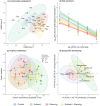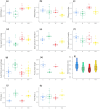Relative Effects of Eutrophication and Warming on Freshwater Ecosystems Across Ecological Levels
- PMID: 40778522
- PMCID: PMC12332823
- DOI: 10.1111/gcb.70410
Relative Effects of Eutrophication and Warming on Freshwater Ecosystems Across Ecological Levels
Abstract
Global change strongly alters biodiversity worldwide, but our ability to predict their consequences for ecosystem functioning remains limited. This lack of knowledge may be attributed to the limited empirical evidence of the simultaneous ecological impacts of global change across multiple ecological levels. Here, we conducted a full factorial experiment to measure the isolated and combined effects of two global change drivers to which freshwater ecosystems are severely exposed: (i) nutrient addition, which mainly affects the lower trophic levels and modifies ecosystems from the bottom of the food chain, and (ii) warming, which primarily affects large organisms at the top of the food chain. We quantified the effects of the two global change drivers at four different ecological levels: community composition (zooplankton and benthic invertebrates), size structure, trophic architecture, and ecosystem functioning. We found that the impacts of treatments varied significantly across different ecological levels. Specifically, community composition was predominantly affected by warming, whereas nutrient addition played a more important role than warming in ecosystem functioning (e.g., primary production and atmospheric CO2 uptake). More importantly, we found that food webs (described using size spectrum and stable isotope structure) represent an integrative ecological level for capturing the effects of the two global change drivers tested, integrating changes in both community structure and ecosystem functioning. These results provide valuable insights into the responses of aquatic ecosystems to global change and reveal the importance of considering multiple ecological levels to improve our understanding of the processes driving the responses of ecosystems to global change.
Keywords: aquatic invertebrates; climate change; eutrophication; food webs; freshwater ecosystems; mesocosms experiment.
© 2025 The Author(s). Global Change Biology published by John Wiley & Sons Ltd.
Conflict of interest statement
The authors declare no conflicts of interest.
Figures




References
-
- Arnér, M. , Koivisto S., Norberg J., and Kautsky N.. 1998. “Trophic Interactions in Rockpool Food Webs: Regulation of Zooplankton and Phytoplankton by Notonecta and Daphnia .” Freshwater Biology 39: 79–90. 10.1046/j.1365-2427.1998.00262.x. - DOI
-
- Bastviken, D. , Cole J., Pace M., and Tranvik L.. 2004. “Methane Emissions From Lakes: Dependence of Lake Characteristics, Two Regional Assessments, and a Global Estimate.” Global Biogeochemical Cycles 18, no. 4: 2238. 10.1029/2004GB002238. - DOI
MeSH terms
Grants and funding
LinkOut - more resources
Full Text Sources
Medical

